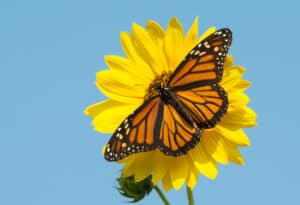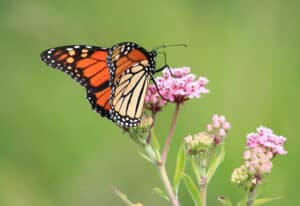On Thursday, November 18th, the Georgia Department of Natural Resources asked the public for help reporting monarch butterfly sightings in Southern states. From December 1st through March 1st, 2022, scientists hope to hear reports of monarch sightings from residents in North Carolina, South Carolina, Georgia, Florida, Alabama, Mississippi, Louisiana and Texas.
The public can make reports at journeynorth.org. Journey North tracks and releases news regarding many species seasonal migrations including a variety of birds and, of course, monarch butterflies.
Why Should You Report Monarch Butterfly Sightings?
Reports of monarch butterfly sightings will help scientists with their research and in turn their conservation efforts. The reports will determine if butterflies can spend their winter as non-breeding adults in the Southern United States.
This information helps scientists understand if any monarch butterflies are staying in the Southern states over the winter instead of migrating to Mexico.
Last winter, more than 5,800 monarch butterflies were sighted in Southern states when the populations were expected to be in Mexico. Monarch butterfly populations are also in significant decline and have been added to the Endangered Species List.
Tracking their migration and changing habits will help scientists focus conservation efforts to save the monarch butterflies.
How to Report Monarch Butterfly Sightings
Journey North has a place to report monarch sightings on their homepage. They are looking for help identifying different types of monarch sightings. They also need all reports to state the number of monarch butterflies observed at a location.
Any photos you take are an important addition to monarch butterfly sighting reports.
If you see a monarch butterfly, please use the following list to add detail to your report:
- Monarch Adults – Were the monarchs exhibiting directional flight? How many adult monarch butterflies did you observe at this one location? How did you estimate the number of monarchs observed?
- Monarch Egg – Please let Journey North know if the egg was on or under a milkweed plant’s leaf.
- Monarch Larva – Please let Journey North know if the larva was on or under a milkweed plant’s leaf.
- Milkweed Plant – One of the easiest ways to help with monarch butterfly conservation efforts is to plant milkweed plants. As one of the butterflies’ primary food sources, milkweed is crucial to their migration and survival.
- Monarch Peak Migration — Monarch Fall migration is spectacular and also unpredictable. People often report seeing large numbers of monarchs flying in a clear “directional” flight, or seeing “hundreds of butterflies” nectaring in a field of flowers fueling up for the long flight. If you witness what seems to be a large number of monarchs for your area (i.e. dozens, hundreds), please report this sighting under PEAK Migration. For reported numbers to be meaningful, please let Journey North know the length of time you spent counting monarchs.
- Monarch Roosts – Migrating monarchs cluster together in trees at night, forming what is called a roost. A roost may have a handful of butterflies or more than you can count. Fall roost reports should reflect the number of monarchs observed within a roost for a single night. In your comments, let Journey North know when the roost formed, how you estimated the number of monarchs roosting, and other information (such as nearby nectar sources, species of tree(s) in roost, and whether the monarchs are shielded from the wind in their location).
- Other Observations – Other observations could include mating, laying eggs, nectaring (please let Journey North know plant species observed if known), basking in the sun, and deceased monarch.
The photo featured at the top of this post is © Dotted Yeti/Shutterstock.com
Sources
- , Available here: https://www.news4jax.com/news/florida/2021/11/20/public-asked-to-report-monarch-butterfly-sightings-in-south-including-florida-and-georgia/
- , Available here: https://journeynorth.org/monarchs
Thank you for reading! Have some feedback for us? Contact the AZ Animals editorial team.






